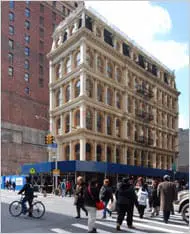Building Sues For Damage Caused By Construction Project

Talk about endangered landmarks.
The elegant cast-iron building at 287 Broadway, which “graphically illustrates the transformation of lower Broadway in the 19th century from a residential boulevard into the city’s commercial center" (as the Landmarks Preservation Commission put it), is leaning about eight inches to the south.
This month, steel shoring is being erected against its south facade to replace the timber bracing that has been in place since late last year. The entire six-story building was vacated Nov. 29 by order of the Department of Buildings, leaving the Pizza Cafe, at the corner of Reade Street, with Christmas holiday decorations still hanging.
“Our engineers feel strongly that 287 Broadway is stable and can be salvaged," said Kate Lindquist, press secretary at the buildings agency. But for the moment, there is no saying when.
That has left the building’s tenants in limbo, uncompensated and uncertain when they can return home or resume business.
“They all know who did it," said David Jaroslawicz, the lawyer for the Yenem Corporation, proprietors of the Pizza Cafe. “There’s no secret here. But nobody’s stepped up to the plate to say: ‘We’d like to take care of the tenants and the commercial space. And we’re sorry."‘
The “who," Mr. Jaroslawicz said, is the John Buck Company of Chicago, a large development concern that is planning a 20-story condominium apartment building called 57 Reade Street, which will form an L shape around the landmark. It was designed by SLCE Architects.
“I do not intend to comment," Greg Merdinger, a principal in the John Buck Company, said by e-mail. “My goal is to simply finish construction of the building."
As the story goes, however, 287 Broadway was already leaning about four inches when excavation for 57 Reade Street began last spring, as permitted by the city. During excavation, monitors attached to the landmark recorded up to four more inches of movement. The city was notified. A vacate order was issued.
Timber shoring, required by the city, was designed by Richard Herschlag, whom the city identified as the developer’s engineer. It was built by Hunter Atlantic Inc., which the city said was also responsible for the new steel shoring.
“To safely rescind the vacate order, the remedial work on the foundation of 287 Broadway must be underway," Ms. Lindquist said. “The developer’s engineer is working to find a way to perform the remedial work on the foundation. We expect the engineer will submit a plan for review within the month. At that time, we can better assess when the vacate order can be safely rescinded."
The saga has attracted coverage in the Lost City blogs, among others.
Mr. Jaroslawicz said the situation pointed to the need for an insurance or bonding mechanism by which owners who were deprived of their businesses by construction accidents could be quickly compensated, rather than waiting years for the courts to straighten things out — as will almost certainly be the case at 287 Broadway.
“The general contractor is going to blame the underpinning subcontractor, who’s going to blame the plant overseer, who’s going to blame the guy operating the backhoe, who’s going to blame the guy operating the crane," he said. “And all the lawyers are going to have a feeding frenzy for the next couple of years."
There is something curiously appropriate about this, since 287 Broadway has been home to numerous lawyers’ offices since its completion in 1872. John B. Snook, a leading architect of the day (the original Grand Central was his work), designed the structure for the estate of Stephen Storm, combining Italianate and French Second Empire styles.
“The prestige of the building was indicated both by the mansard roof and an early Otis passenger elevator," the landmarks commission said in its 1989 designation report. It added, “Above the first story, the exterior of 287 Broadway looks much as it did in 1872." This includes a 96-foot-long facade on Reade Street with 52 enormous arched windows, six of them set in monumental dormers.
Antoine Scott, a street vendor on Broadway, has been watching the structural drama from his table full of socks, hats and gloves. “I’m just hoping that doesn’t fall down when I’m working here," he said. “That’s what I’m talking about."
Mr. Jaroslawicz did not sound too confident about the fate of the “leaning tower of pizza," as he calls it. “Don’t breathe too heavily," he cautioned. “It might collapse."
But city officials sound confident that 287 can and will be saved. “Absolutely," said John Weiss, deputy counsel of the Landmarks Preservation Commission.
“Unless it was determined by the Department of Buildings that there was an immediate danger to public safety and the building had to be taken down right away," Mr. Weiss continued, “a permit would have to be obtained from Landmarks for demolition.
“It would be fair to say that the chance would be infinitesimal that the landmarks commission would authorize demolition of that landmark."
